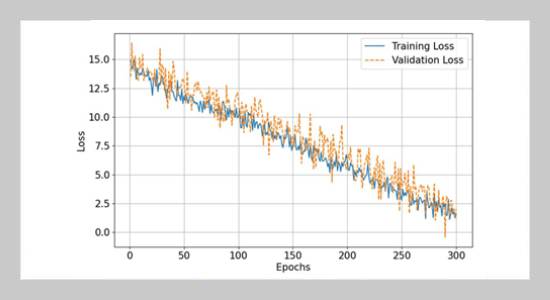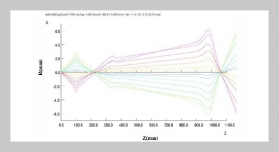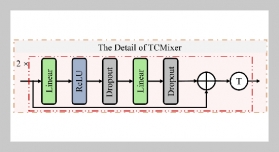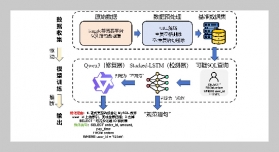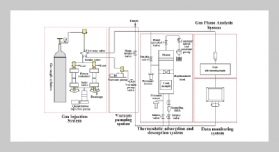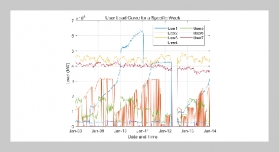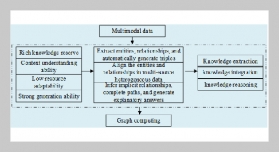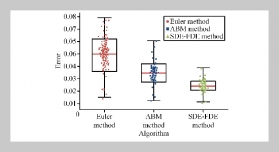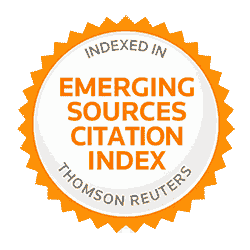- [1] D.Yukhnenko, L. Farouki, and S. Fazel, (2023) “Crim inal recidivism rates globally: A 6-year systematic review update" Journal of criminal justice 88: 102115. DOI: 10.1016/j.jcrimjus.2023.102115.
- [2] C. Penate. “Rebuilding Risk Assessment Tools and Evaluating Their Effect on Recidivism in Illinois". (mathesis). Loyola University Chicago, 2023.
- [3] O. Kovalchuk, M. Karpinski, S. Banakh, M. Kasianchuk, R. Shevchuk, and N. Zagorodna, (2023) “Prediction machine learning models on propensity convicts to criminal recidivism" Information 14: 161. DOI: 10.3390/info14030161.
- [4] M. Cavus, M. N. Benli, U. Altuntas, M. Sari, H. Ayan, and Y. F. Ugurluoglu, (2025) “Transparent and bias resilient AI framework for recidivism prediction using deep learning and clustering techniques in criminal jus tice" Applied Soft Computing: 113160. DOI: 10.1016/j.asoc.2025.113160.
- [5] D. Mu, S. Zhang, T. Zhu, Y. Zhou, and W. Zhang, (2024) “Prediction of recidivism and detection of risk fac tors under different time windows using machine learning techniques" Social Science Computer Review 42(6): 1379–1402. DOI: 10.1177/08944393241226607.
- [6] K. M. A. Haque, S. Rao, B. Nasirian, V. C. P. Chen, C. Kan, and Y. Zhou. “Classification for Predicting Recidivism: Challenges and Scopes”. In: IISE Annual Conference. Proceedings. Institute of Industrial and Systems Engineers (IISE), 2024, 1–6. DOI: 10.21872/2024IISE_6000.
- [7] S. Sultana, I. Jahir, M. Suukyi, M. M. R. Nabil, A. Waziha, and S. Momen. “Advancing Recidivism Prediction for Male Juvenile Offenders: A Machine Learning Approach Applied to Prisoners in Hunan Province”. In: Springer, 2023, 184–201. DOI: 10.1007/978-3-031-54820-8_16.
- [8] M. L. Angondji, M. Chitauro, and F. B. Shava. “Evaluating Machine Learning Models Best Fit for Crime Prediction in Windhoek”. In: 2024 International Conference on Artificial Intelligence, Big Data, Computing and Data Communication Systems (icABCD). IEEE, 2024, 1–6. DOI: 10.1109/icABCD62167.2024.10645286.
- [9] S. Etzler, F. D. Schönbrodt, F. Pargent, R. Eher, and M. Rettenberger, (2024) “Machine learning and risk assessment: Random forest does not outperform logistic regression in the prediction of sexual recidivism" Assessment 31: 460–481. DOI: 10.1177/10731911231164624.
- [10] M. M. Motevalli, M. K. Sohrabi, and F. Yaghmaee, (2025) “Aspect-based sentiment analysis: A dual-task learning architecture using imbalanced maximized-area under the curve proximate support vector machine and reinforcement learning" Information Sciences 689: 121449. DOI: 10.1016/j.ins.2024.121449.
- [11] O. Kovalchuk, R. Shevchuk, L. Babala, and M. Kasianchuk, (2024) “Support vector machine to criminal recidivism prediction" International Journal of Electronics and Telecommunications: 691–967. DOI: 10.24425/ijet.2024.149598.
- [12] G. Wang, S. W. H. Kwok, D. Axford, M. Yousufuddin, and F. Sohel, (2023) “An AUC-maximizing classifier for skewed and partially labeled data with an application in clinical prediction modeling" Knowledge-based systems 278: 110831. DOI: 10.1016/j.knosys.2023.110831.
- [13] P. Zareeihemat, S. Mohamadi, J. Valipour, and S. V. Moravvej, (2025) “Forecasting stock market volatility using housing market indicators: A reinforcement learning based feature selection approach" IEEE Access: DOI: 10.1109/ACCESS.2025.3554224.
- [14] Y. Zhao, W. Zhang, and X. Liu, (2024) “Grid search with a weighted error function: Hyper-parameter optimization for financial time series forecasting" Applied Soft Computing 154: 111362. DOI: 10.1016/j.asoc.2024.111362.
- [15] A. Mehdary, A. Chehri, A. Jakimi, and R. Saadane, (2024) “Hyperparameter optimization with genetic algorithms and XGBoost: a step forward in smart grid fraud detection" sensors 24: 1230. DOI: 10.3390/s24041230.
- [16] S. V. Moravvej, S. J. Mousavirad, D. Oliva, G. Schae fer, and Z. Sobhaninia. “An improved de algorithm to optimise the learning process of a bert-based pla giarism detection model”. In: 2022 IEEE congress on evolutionary computation (CEC). IEEE, 2022, 1–7. DOI: 10.1109/CEC55065.2022.9870280.
- [17] A. A. Aghaei and K. Parand, (2025) “Hyperparameter optimization of orthogonal functions in the numerical solution of differential equations" Mathematical Methods in the Applied Sciences 48: 605–625. DOI: 10.1002/mma.10346.
- [18] G. Maheswari, S. Felixa, A. J. Vidhya, M. Sambath, and K. Remya. “Forecasting of Crime Hotspots and Analysis using Machine Learning”. In: 2024 Interna tional Conference on Advances in Data Engineering and Intelligent Computing Systems (ADICS). IEEE, 2024, 1–5. DOI: 10.1109/ADICS58448.2024.10533569.
- [19] A. Dubey, N. Venu, D. Bisen, P. Garg, K. Srinivas, and H. Arya. “A Clustering-Based Method for Hotspot Recognition in Crime Forecasting”. In: 2024 IEEE 8th International Conference on Information and Communication Technology (CICT). IEEE, 2024, 1–6. DOI: 10.1109/CICT64037.2024.10899713.
- [20] R. Ahmad, A. Nawaz, G. Mustafa, T. Ali, M. Tlija, M. A. El-Meligy, and Z. Ahmed, (2024) “CHART: Intelligent Crime Hotspot Detection and Real-Time Track ing Using Machine Learning." Computers, Materials &Continua 81: DOI: 10.32604/cmc.2024.056971.
- [21] A. Morin-Martel, (2024) “Machine learning in bail decisions and judges’ trustworthiness" Ai & Society 39: 2033–2044. DOI: 10.1007/s00146-023-01673-6.
- [22] L. Yang, J. Guofan, Z. Yixin, W. Qianze, Z. Jian, R. Alizadehsani, and P. Pławiak, (2024) “A reinforcement learning approach combined with scope loss function for crime prediction on Twitter" IEEE Access: DOI: 10.1109/ACCESS.2024.3473296.
- [23] Z. Yixin, L. Yang, J. Guofan, Z. Jian, J. Yang, R. Al izadehsani, R. Tadeusiewicz, and P. Pławiak, (2025) “An off-policy deep reinforcement learning-based active learning for crime scene investigation image classifica tion" InformationSciences710:122074. DOI:10.1016/j.ins.2025.122074.
- [24] A. Sedik, H. Kolivand, and M. Albeedan, (2024) “An efficient image classification and segmentation method for crime investigation applications" Multimedia Tools and Applications: 1–25. DOI: 10.1007/s11042-024 19773-w.
- [25] S. Sandhya, A. Balasundaram, and A. Shaik, (2023) “Deep Learning Based Face Detection and Identification of Criminal Suspects." Computers, Materials & Continua 74: DOI: http: //dx.doi.org/10.32604/cmc.2023.032715.
- [26] J. H. Jhee, M. J. Kim, M. Park, J. Yeon, and H. Shin, (2023) “Fast Prediction for Criminal Suspects through Neighbor Mutual Information-Based Latent Network" International Journal of Intelligent Systems 2023: 9922162. DOI: 10.1155/2023/9922162.
- [27] M.Barash, D. McNevin, V. Fedorenko, and P. Giverts, (2024) “Machine learning applications in forensic DNA profiling: A critical review" Forensic Science International: Genetics 69: 102994. DOI: 10.1016/j.fsigen.2023.102994.
- [28] Y. Lee, B. Bradford, and K. Posch, (2024) “The effectiveness of big data-driven predictive policing: systematic review" Justice Evaluation Journal 7: 127–160. DOI: 10.1080/24751979.2024.2371781.
- [29] E. Ingram, F. Gursoy, and I. A. Kakadiaris. “Accu racy, fairness, and interpretability of machine learning criminal recidivism models”. In: 2022 IEEE/ACM International Conference on Big Data Computing, Appli cations and Technologies (BDCAT). IEEE, 2022, 233–241. DOI: 10.1109/BDCAT56447.2022.00040.
- [30] Y. Ma, K. Nakamura, E.-J. Lee, and S. S. Bhat tacharyya. “Eadtc: An approach to interpretable and accurate crime prediction”. In: 2022 IEEE International Conference on Systems, Man, and Cybernetics (SMC). IEEE, 2022, 170–177. DOI: 10.1109/SMC53654.2022.9945130.
- [31] O. Kovalchuk, S. Banakh, M. Masonkova, V. Burdin, O. Zaverukha, and R. Ivanytskyy. “A Scoring Model for Support Decision Making in Criminal Justice”. In: 2022 12th International Conference on Advanced Com puter Information Technologies (ACIT). IEEE, 2022, 116 120. DOI: 10.1109/ACIT54803.2022.9913182.
- [32] T. Babad and S. A. Chun. “Enhancing accuracy and explainability of recidivism prediction models”. In: The International FLAIRS Conference Proceedings. 36. 2023. DOI: 10.32473/flairs.36.133382.
- [33] Y. Lee, S. O, and J. E. Eck, (2025) “Improving Recidivism Forecasting With a Relaxed Naïve Bayes Classifier" Crime & Delinquency 71: 89–117. DOI: 10.1177/00111287231186093.
- [34] A. Singh and S. Mohapatra. “Automatic Criminal Recidivism Risk Estimation in Recidivist Using Classification and Ensemble Techniques”. In: Springer, 2023, 279–289. DOI: 10.1007/978-981-19-6525-8_22.
- [35] C. Wang, B. Han, B. Patel, and C. Rudin, (2023) “In pursuit of interpretable, fair and accurate machine learning for criminal recidivism prediction" Journal of Quantitative Criminology 39: 519–581. DOI: 10.1007/s10940-022-09545-w.
- [36] S. Etzler, F. D. Schönbrodt, F. Pargent, R. Eher, and M. Rettenberger, (2024) “Machine learning and risk assessment: Random forest does not outperform logistic regression in the prediction of sexual recidivism" Assessment 31: 460–481. DOI: 10.1177/10731911231164624.
- [37] S. Bentos, E. Bailis, F. Oikonomou, S. Spirou, E. Mavrikos, S. Chatzistamatis, K. Kotis, and G. E. Tsek ouras. “Evaluation of Fairness in Machine Learning Based Recidivism Predictions: the Case of Greek Fe male Prison System”. In: 2024 4th International Conference on Innovative Research in Applied Science, Engi neering and Technology (IRASET). IEEE, 2024, 1–8. DOI: 10.1109/IRASET60544.2024.10548202.
- [38] J. K. Athota, K. K. Parimi, M. K. Teja, M. A. Bhavani, and M. M. Y. Devi. “Fairness in Predicting Recidi vism Score”. In: International Conference on Smart Data Intelligence. Springer, 2024, 239–253. DOI: 10.1007/978-981-97-3191-6_18.
- [39] Y. Lee and S. O, (2025) “Redefining Recidivism Prediction: The Impact of Race and Geographic Lo cation in Machine Learning Models" Crime & Delinquency: 00111287251316515. DOI: 10.1177/ 00111287251316515.
- [40] G. M. Circo and A. P. Wheeler, (2025) “An open source replication of a winning recidivism prediction model" International Journal of Offender Therapy and Comparative Criminology 69: 438–453. DOI: 10.1177/0306624X221133004.
- [41] Y. Lee, S. O, and J. E. Eck, (2025) “Improving Recidivism Forecasting With a Relaxed Naïve Bayes Classifier" Crime & Delinquency 71: 89–117. DOI: 10.1177/00111287231186093.
- [42] M. Saberian, V. Samadi, and I. Popescu, (2024) “Probabilistic Hierarchical Interpolation and Interpretable Configuration for Flood Prediction" Hydrology and Earth System Sciences Discussions 2024: 1–41. DOI: 10. 5194/hess-2024-261.
- [43] H. Najafi, K. Savoji, M. Mirzaeibonehkhater, S. V. Moravvej, R. Alizadehsani, and S. Pedrammehr, (2024) “A Novel Method for 3D Lung Tumor Reconstruc tion Using Generative Models" Diagnostics 14: 2604. DOI: 10.3390/diagnostics14222604.
- [44] M. Merikhipour, S. Khanmohammadidoustani, and M. Abbasi, (2025) “Transportation mode detection through spatial attention-based transductive long shortterm memory and off-policy feature selection" Expert Systems with Applications 267: 126196. DOI: 10.1016/j.eswa.2024.126196.
- [45] A. Kokhahi and D. Li, (2024) “GLHAD: A group lasso based hybrid attack detection and localization framework for multistage manufacturing systems" Journal of Computing and Information Science in Engineering 24: DOI: 10.1115/1.4063862.
- [46] S. M. S. Mohammadabadi, M. Entezami, A. K. Moghaddam, M. Orangian, and S. Nejadshamsi, (2024) “Generative artificial intelligence for distributed learning to enhance smart grid communication" Interna tional Journal of Intelligent Networks 5: 267–274. DOI: 10.1016/j.ijin.2024.05.007.
- [47] J. Xiang, (2025) “The duration and high-hazard factors of food crimes in China: an empirical study with automatic text analytics" Crime, Law and Social Change 83: 1 20. DOI: 10.1007/s10611-025-10214-9.
- [48] A. N. Tamar, M. Karbasi, M. R. Khani, T. Hamzehlouyan, and B. Shokri, (2023) “Response sur face methodology (RSM) for optimizing ozone-assisted process parameters for formaldehyde removal" Journal of Environmental Health Science and Engineering 21: 475–484. DOI: 10.1007/s40201-023-00873-y.
- [49] A. Shafiee, H. R. Moghadam, M. Merikhipour, and J. Lin. “Analyzing Post-Pandemic Remote Work Accessibility for Equity through Machine Learning Analysis”. In: International Conference on Transportation and Development 2024. 2024, 453–462. DOI: 10.1061/9780784485521.041.
- [50] S. Thundiyil, S. S. Shalamzari, J. Picone, and S. McKenzie. “Transformers for Modeling Long-Term Dependencies in Time Series Data: A Review”. In: 2023 IEEE Signal Processing in Medicine and Biology Symposium (SPMB). IEEE, 2023, 1–5. DOI: 10.1109/SPMB59478.2023.10372632.
- [51] B. Thai, S. McNicholas, S. S. Shalamzari, P. Meng, and J. Picone. “Towards a More Extensible Machine Learning Demonstration Tool”. In: 2023 IEEE Signal Processing in Medicine and Biology Symposium (SPMB). IEEE, 2023, 1–5. DOI: 10.1109/SPMB59478.2023.10372731.
- [52] M. A. L. Khaniki, A. Golkarieh, H. Nouri, and M. Manthouri, (2024) “Enhanced fault detection and cause identification using integrated attention mechanism" arXiv preprint arXiv:2408.00033: 1–36. DOI: 10.48550/arXiv.2408.00033.
- [53] M. Entezami, S. Basirat, B. Moghaddami, D. Bazman deh, and D. Charkhian, (2025) “Examining the Im portance of AI-Based Criteria in the Development of the Digital Economy: A Multi-Criteria Decision-Making Approach" Journal of Soft Computing and Decision Analytics 3: 72–95. DOI: 10.31181/jscda31202555.


